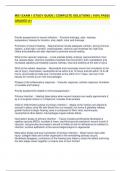MS1 EXAM 1 STUDY GUIDE | COMPLETE SOLUTIONS | 100% PASS|
GRADED A+
Priority assessment for wound infection - Purulent drainage, odor, redness;
temperature; Assess for location, size, depth, color and drainage
Promotion of wound healing - Requirements include adequate nutrition, strong immune
system, a diet high in protein, carbohydrates, vitamins and moderate fat, high fluid
intake and platelets are also important to promote wound healing
What is the vascular response - Local arterials briefly undergo vasoconstriction; then
the vessels dilate; chemical mediators facilitate fluid movement; both vasodilation and
increased capillary permeability causes redness, heat and swelling at the site of injury
What is the cellular response - Neutrophils and monocytes move from circulation to the
site of injury; chemotaxis; neutrophils arrive within 6 to 12 hours and die within 12 to 48
hours, accumulate & make pus; monocytes arrive within 3 to 7 days, can live in the
tissues for months & turn into macrophages
Phases of the inflammatory response - Vascular response, cellular response, formation
of exudate and healing
Priority assessment related to immunosuppression -
Primary intention - Healing takes place when wound margins are neatly approximate it,
as in a surgical incision or a Papercut; includes three phases
Initial or inflammatory phase of primary intention - edges of the incision are aligned &
sutured in place; area fills with blood from cut vessels; clot forms & platelets release
growth factors to begin healing; area is composed of fibrin clots, erythrocytes,
neutrophils & other debris; macrophages ingest cellular debris
Granulation phase of primary intention - Tissue includes proliferating fibroblasts &
capillary sprouts,WBCs, exudate & loose, semifluid ground substance; wound is pink &
vascular, red granules are present; wound is friable at risk for dehiscence & resistant to
infection; surface epithelium at the wound edges begins to regenerate
Maturation phase and scar contraction of primary intention - Begin seven days after
injury; collagen fibers are further organized in the remodeling process occurs;
fibroblasts disappear; contraction of the healing area helps to close the defect and bring
the skin edges closer together; a mature scar is then formed
, Secondary intention - Large amounts of exudate and wide, a regular wound margins
with extensive tissue loss; edges cannot be approximated; may need to be debrided
before healing can take place; the major differences between secondary and primary
are the greater defects and the gaping wound edges
Tertiary intention - Delayed primary intention; purposefully left open due to infection;
delayed sutures after infection is controlled
How often should a bed ridden patient be turned - Every 2 hours
What is the number one prevention strategy for pressure ulcers - Repositioning and
mobilization
Vitiligo - Total loss of pigment in the affected area; complete absence of melanin
resulting in chalky, white patch; autoimmune, family history and thyroid disease
Squamous cell carcinoma - Frequent occurrence on previously damaged skin for
example from sun, radiation or scar; malignant tumor of squamous cell of epidermis;
invasion of dermis and surrounding skin
Squamous cell carcinoma appearance - Superficial as thin, scaly, erythematous plaque
without invasion into the dermis; early is firm nodules with indistinct borders, scaling and
ulceration; late is covering of lesion with scale or horn from keratinization and ulceration;
most common on sun-exposed areas such as face and hands
Squamous cell carcinoma treatment - Surgical excision, cryosurgery, radiation therapy,
chemotherapy, electrodesiccation and curettage; untreated lesion may metastasized to
regional lymph nodes and distant organs; high cure rates with early detection and
treatment
Prevention of deep vein thrombosis - Early ambulation and repositioning; antiembolism
stockings or compression devices applied to the legs
Latex food allergies - The most common of these foods are banana, avocado, chestnut,
kiwi, tomato, water chestnuts, guava, hazelnut, potato, peach, grape and apricot
Post op assessment priorities - Airway & respiratory status is # 1 priority; assess
surgical sites, drains, wound dressings; signs of hypocalcemia, hyperglycemia, acidosis
or alkalosis; assess for return of bowel sounds; expect clients void in 6-8 hrs; if given
narcotic, assess q 30 minutes for pain relief and respiratory rate
Malignant hyperthermia - Causes potentially fatal rigidity of skeletal muscles when
exposed to anesthesia; autosomal dominant but variable expression; signs include
tachycardia, tachypnea, hypoxemia, lactic acidosis, ventricular dysrhythmias,
hyperthermia and cardiac arrest; treatment is with dantrolene




